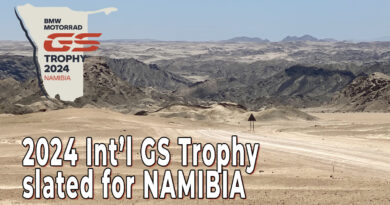Trail braking = Cornering confidence
Riding a motorcycle is easy. Riding a motorcycle well is not. It requires a variety of skills and the determination to acquire them. No matter how hard a motorcyclist strives, until one particular skill is discovered, they will always be searching for it. Once they have it, they will wonder how they ever rode a motorcycle without it.
Hands down, the best motorcycling technique is trail braking. It provides a method for precisely controlling speed and steering throughout an entire corner. What could be more important than that?
Through my coaching, I’ve discovered that many people simply overlook the power of trail braking, especially those interested in sport riding. While everyone may not appreciate it, many riders could be taking advantage of this brake/throttle transitioning finesse.
What is Trail Braking?

The first person to ever use the term “trail braking” related to motorcycling seems to be lost to history. At least I’ve never been able to identify him or her. Why whomever it was chose to combine the word “trail” with “braking” is a mystery as well.
The closest explanation I’ve heard is the idea that you trail or “drag along” braking as you lean into a turn. In other words, one trails off from firm brake pressure at corner entry until full release near the apex. I’ve also found the term curiously similar to the trail on a motorcycle’s steering geometry. Properly applying this technique compresses the fork tubes, effectively decreasing trail resulting in quicker steering.
For trail braking to be a thing, corner entry speed must be relatively faster. This necessitates holding onto the brakes past the corner entry to prevent running wide.
Frankly, I think the term is confusing. First of all, it really isn’t a braking technique. It’s a cornering technique. Trail braking is when a rider transitions from brake to throttle at the lowest mph speed in a curve.
Sometimes the lowest mph speed is at the corner entry if going slow. If entering way too fast, the lowest mph speed might be near the corner exit. Sport riding typically designates the corner apex as the lowest mph speed. In any of these scenarios, a rider transitions from brake to throttle at some point. When this transition happens at the entrance of a curve, we call that adding throttle. When this transition happens at some point leaning in the curve, we call that trail braking.
The trail braking concept allows riders to be more flexible with each new corner they encounter. The skills that make trail braking work can be used for any corner at any speed. It usually doesn’t require learning anything new. I suspect most riders are either doing it to some degree already or really close.
How to Do It?
 At the heart of trail braking is a properly timed front brake-to-throttle transition. There are two major requirements to do this: using a specific right-hand technique and identifying the location of the transition.
At the heart of trail braking is a properly timed front brake-to-throttle transition. There are two major requirements to do this: using a specific right-hand technique and identifying the location of the transition.
Controlling our steering while turning is the result of first controlling our speed. When approaching a corner, we must slow to prevent continuing on a straight path. Exiting requires acceleration to bring the motorcycle back to another straight path. Somewhere unknown upon entry between those two points, we have to release our brake lever and apply throttle. Therefore, we have to be ready when the time comes to apply the correct speed control.
Precisely transitioning from brake to throttle with minimal reaction time begins with a hand position suitable for the job. Never corner with your right hand in a fist. While variations exist, the default position I recommend is resting your first two fingers on the brake lever and wrapping the last two fingers around the throttle.
From there, roll up your wrist to ensure the throttle is closed and delicately apply brake pressure in a downward direction like you’re squeezing juice from an orange. Next, transition to the throttle by first gently releasing the brake lever completely. At about the same time the brake is fully released, use your hand to delicately roll down on the throttle. When doing this, allow the two braking fingers to glide along the lever without pulling it in.
Do not use both brake and throttle at the same time. Apply one control, release it and then apply the other.
The “roll it up” and “roll it down” techniques, as I call them, can be easily practiced in your garage on a static motorcycle. Send me a video of your technique, and I’d be happy to coach you from home. Within just a few rides, these techniques become second nature.
Some people might be wondering why I haven’t mentioned the rear brake. While the rear brake can be used to slow a motorcycle at lean, it’s not as effective or safe for trail braking on the street. The most important reason is related to the forward motorcycle weight shift upon corner entry and its effect on tire traction. The front tire can better handle the demands of braking and turning at this point than can the rear.

The second requirement to proper trail braking is identifying the lowest mph speed in a turn or curve. This is where to use the roll it down technique and transition from brake to throttle. There will be an exact point where we release the brake and roll on the throttle. However, at the beginning of the turn, we’re not sure where that point will be until we actually get there.
It’s fairly simple to identify the slowest point of the curve. As you slow into a curve, there will come a point where you realize that continuing to slow the motorcycle any more will cause it to fall too far inside the turn. That’s your cue to add throttle.
The correct feel for this technique is developed through the natural delay between braking and throttle. Smoothly transitioning between these two controls allows for a seamless drive from the corner apex to exit.
If we’re not using the proper hand placement and techniques described earlier and all of our fingers are fully wrapped around the throttle grip, we lack the fine dexterity and reaction time necessary to act at the lowest mph speed.
Why Do It?
Many people dismiss trail braking as a racing technique. It’s true, the fastest riders in the world do use it. However, the benefits are even more plentiful for street riders and canyon carvers.
Race track riders know every detail about their curves. Their goal with the technique is to get faster lap times. This is evident when they occasionally low side after braking past traction limits at lean and lose front tire grip.
Street riders use trail braking to control their speed and steering through 100 percent of the curve. On the backroads, riders have no idea what’s around the bend or on the surface. By controlling our speed and steering with the front brake, we can confidently proceed until we have a clear picture of our path.
In addition to the speed and steering control benefits, trail braking also provides improved front tire traction when it’s needed the most. This is the moment where a rider initiates lean in the first half of a curve. Entering a curve using the front brake purposefully shifts more weight to the front tire. We want to weight a tire before fully trusting traction. Creating this slight weight bias forward provides a rich contact patch up front for a change in direction.
The trail braking cornering technique is not yet universal in the sport of motorcycling. My Cornering Confidence program aims to change that. This essential skill gives motorcyclists the ability to completely control the speed and steering of any motorcycle at all times. Without it, they become passengers at the most critical point of every curve.
Visit the Street Skills Trail Braking page to learn more.
Street Skills online courses are available for a discounted rate to BMW MOA members. To join the MOA and take advantage of this and many other member benefits, visit bmwmoa.org. Learn more about Jon DelVecchio’s courses at streetskills.net.


